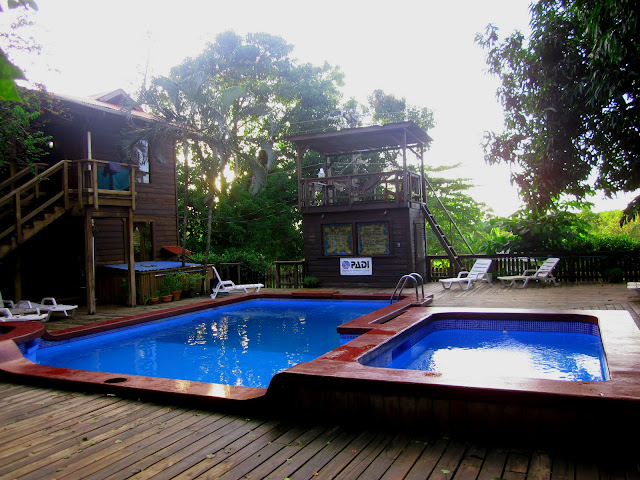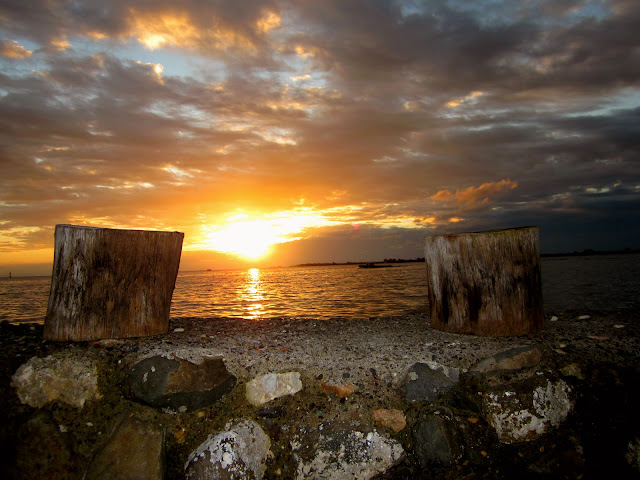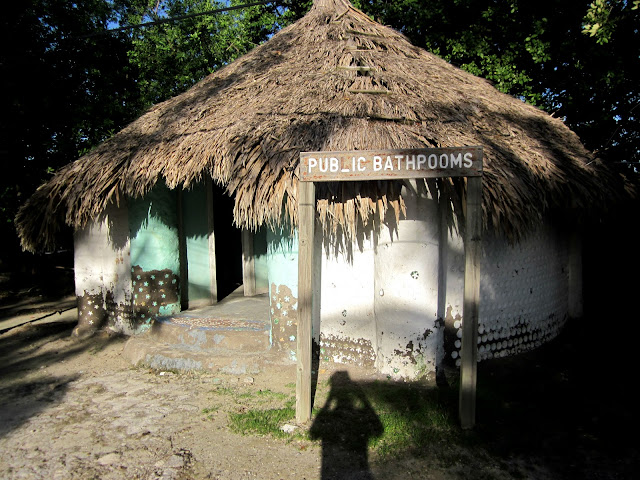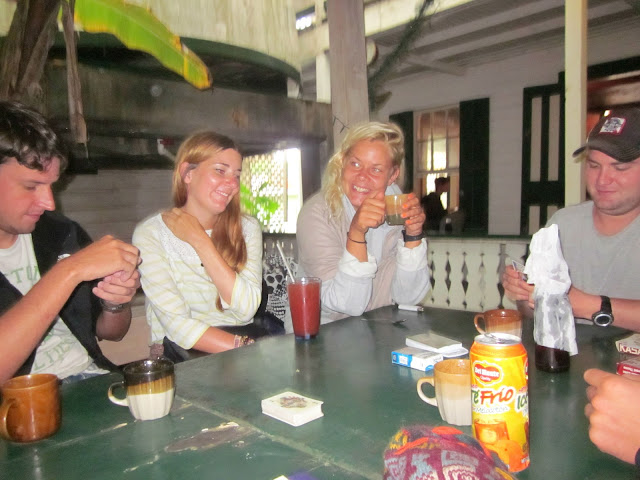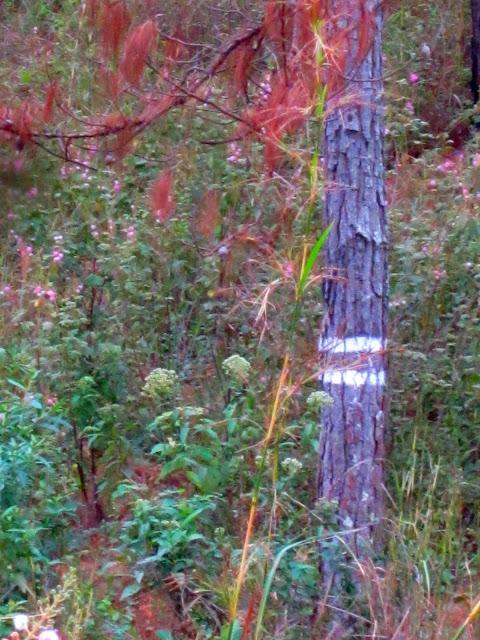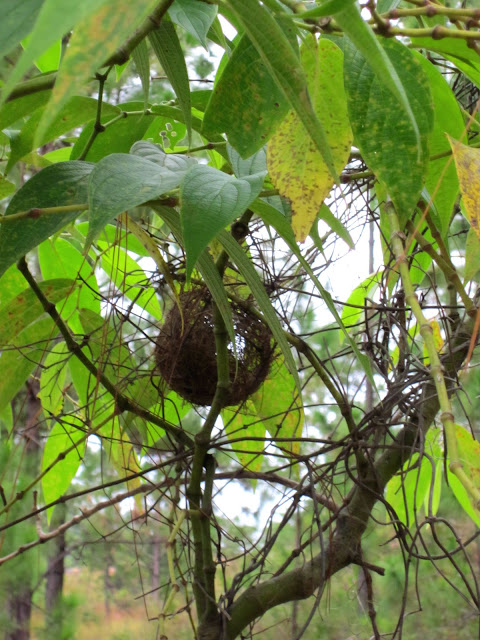As promised, this is me posting my pictures from Utila. I'm home-sweet-home in Tegucigalpa after spending a long and eventful week on the tropical isle. Overall, my experience there was incredible. I traveled nine hours by bus and by ferry each way. I met people from all over the world including England, Scotland, Germany, Belgium, Switzerland, Israel, Ukrane, Sweden, Denmark, the Netherlands, Canada, Australia, New Zealand, Guatemala, Italy, France, Japan, and in the States, from California, South Carolina, Massachusetts, Wisconsin, Hawaii, etc. I breathed under 60 feet of water. I witnessed a sea turtle clean its fin (strangely adorable). I watched plankton glow like stars while sitting on the ocean floor at night. I drank too many gin-n-tonics one night and stumbled my way back to the hostel. I tried lobster quesadillas, lobster pasta, and the super-mega-baleada which included lobster, shrimp, and fish. I received my Open Water Certification in scuba diving. I shared a toilet and a shower with maybe thirty or so strangers. I was stranded for a few days while the island waited for a storm to blow over.
And this is Utila's off season.
Unfortunately, I didn't take as many pictures as I would have liked, especially considering all the fabulous people I met and all the beautiful things I saw, but the pictures I did take give a roundabout idea of what life on the island is like.
This is the view from the ferry dock in La Ceiba. Note the familiar green mountains in the background typical of mainland Honduras.
These are the two ferries that dock in La Ceiba: the big, fancy one in back that looks like a cruise ship goes to Roatan and the flat one in the foreground goes to Utila, the "backpacker island."
The first place I stayed in Utila was called the Mango Inn. If you stay in the dormitory-style rooms, it cost about $10/night. If you get a dive certification with Utila Dive Center (the Mango Inn's affiliate dive school) accommodation is free. The room included two bunk beds; with whom you share a room is decided by whoever happens to check in at that time. Bathrooms and showers are communal. Those first two nights I stayed with Ilona and Caroline, friends of the English guys I met at the ferry dock.
The next night I paired up with Heather (from London) whom I met on my way home form Utila Dive Center and we decided to seek different accommodation. The Mango Inn was too far away from downtown, especially if one needs to stumble home at certain hours of the night (not that I planned on doing this, of course). Besides, it was about a 15 minute walk to the dive center from the Inn. Many dive schools on the island either have their own rooms to house students or are affiliated with a hostel. The Mango Inn and Utila Dive Center go together, so we had to sign up at a different PADI school as well. After checking out three other dive schools, we ended up deciding on Underwater Vision. When Heather and I showed up to explain to the staff at UDC we would not be using their services, I opened my mouth to speak but Heather said unceremoniously, "The Mango Inn is shit." A true dive buddy.
This is a picture of the Underwater Vision grounds. The school, the beach, and the dive boat docks are all right in this vicinity. The office is located in the house to the right. Under the house, Underwater has a restaurant/bar that serves great food.
Another picture of the grounds. Yes, those are buff men playing volleyball. Strangely, many of the men fit the beach-bum/surfer-dude stereotype. I think they might be sneaking workouts in between dives.
Hammock time. In Utila, if you snooze you do not lose.
This is a confusing pic of the dock. The red roof and the wood pillars belong to Underwater Vision but the boat behind it makes it look like the dock has windows. You can't see it from this photo, but the front part of the dock had swings hanging from the roof so one could swing out over the ocean. I took this photo during the storm so it's pretty cloudy.
The entirety of Underwater Vision's grounds is sand.
Taken at sunset.
Here are some random pics around the island:
Almost all of the houses stood on stilts.
An interesting concept. . .
I took these next two pictures behind a house on the main street (on the side opposite the ocean). This is the lagoon and it feeds into the ocean. Many boats dock here, including the yellow one below which belongs to Cross Creek Dive Center.
Putting on a show.
Not sure how this building functions, but it's pretty.
On Utila, one can go to the dentist and buy a casket (with straps!).
When I first saw this, I actually thought, "Wow, they offer rehab on this island. That is so amazing." Turns out, "rehab" means "rum;" it's actually the name of a bar.
One takes the 12 steps towards getting sloshed.
Babalu's is popular place to eat. Many of the best eateries on Utila look a little sketch, but serve high-quality, large-portioned food.
Ok. I made this picture red. I thought it would be funny. The truth is, for many, Utila is quite the booze-pot-coke tour. One can walk into any bar, quite easily and without social stigma, and ask where to buy drugs or even make the transaction right there. For most of the people I met, this wasn't weird. However, I grew up in Grandville, Michigan, where people who do coke are assumed to be skeezy, creepy sickos in trench coats. Needless to say, I was a bit shocked. At one point, I witnessed someone snort a line of cocaine in my room off a copy of The Lonely Planet guide, the backpacker Bible. Fitting.
On a happier note, this is Space Cakes. His eyes are two different colors.
This is Bec holding Space Cakes. She is from Australia. If you have been around the Brisbane area and have seen a giant banana statue, you've passed Bec's house.
This is some of the Underwater gang (about half the people actually at Munchies that day) eating breakfast at Munchie's (basically the only place open on Sunday). Note the Blood Mary and the coffee with rum. While spending time around backpackers, I got the sense that taking pictures was a little nerdy, as if backpackers aren't tourists and they don't need the tokens. Hence, my lack of pictures with actual people. When in Rome, I suppose.
(From the left: Galen, Heather, Frida, and Dan).
The "cinema" is known for it's shakes. I never "saw a movie" there but I the building was no bigger or better than any other in Utila so I am assuming the "movie theater" was a room with a projector and a screen. I ordered the much-recommended peanut butter-banana shake to go and this delicious bag of liquid was presented to me.

I received my Open Water scuba diving certification with PADI, the biggest scuba diving organization in the world. After Open Water, one can do 5 specialty dives such as a night dive, a wreck dive, a deep water dive, a navigation dive, and a buoyancy dive in order complete an Advanced Certification.These specialty dives are the first dives needed to complete a specialty course. After that, one needs to complete the Rescue course in order to go on be a Diver Master (40 dives needed) and eventually an Instructor. Many of the regulars at Underwater Vision (and on the island) had traveled to Utila and, without expecting to, stayed for months to complete the dive master course. Turns out, Utila is quite addicting. Yes, there are drugs. However, the vibe on the island is relaxing in general. Almost everyone who travels there is amiable and inclusive. Really, there aren't clicks with backpackers. Instead, there's an unspoken sense of camaraderie, everyone is traveling with next to no possessions, little money, a couple of intestinal parasites, and an adventurous spirit. Plus, everything on Utila is cheap if not resellable.
Over the course of the week, I completed five dives, one of which was a night dive. For the most part, I enjoyed them. In order to really appreciate being able to breath underwater, I would have to dive a lot more. That something-might-happen-and-I-might-die-a-horrible-death feeling never really left. Mostly, I attribute this to a list of the major things that could actually go wrong. These were highlighted dramatically in the PADI videos and by the instructors. I have listed some of them here for your convenience:
- One should always keep breathing underwater. Otherwise, when one ascends the surface one's lungs will expand too much burst.
- One should always "equalize," or force airflow within the sinuses (as one does on a plane) when descending and ascending. Otherwise, one will burst an ear drum.
- One should always breath slower and deeper than normal. Breathing too shallow will deplete the air supply faster.
- One should never ascend at a rate faster than 18m/minute for fear of bursting the lungs.
- One should make a "safety stop" after descending to a certain depth because one's body needs time to release the nitrogen (found in greater quantities at deeper depths) from the blood stream. If the nitrogen is not dispelled, one develops decompression sickness, the nitrogen bubbling below the skin. The body may even develop the "bends," a condition in which one's limbs begin to contract uncontrollably.
But, you know, don't sweat the small stuff.
As far as the night dive went, well, I discovered that I wasn't as comfortable with diving as I thought. I spent most of the dive trying to coordinate my torch (flashlight)/fins/ goggles/BCD in a way that didn't destroy any coral reef or hit anyone else.
There's good news. At least, if something does go wrong and you find your limbs contacting mysteriously and without your consent, Utila has it's own hyperbaric chamber. My dad, Randy Kehr, is responsible for running the hyperbaric chambers at Spectrum Health Hospitals in Grand Rapids, MI. The pics below were taken in his honor. The chamber treats decompression sickness by allowing a person to exist in an environment of nearly-pure oxygen (from what I understand) thereby ridding the bloodstream of the excess nitrogen. Each treatment in the chamber can take hours and usually requires return visits.

Prepare the chamber!
This is Ben. Imagine my surprise, when I found a fellow Laker and West Michigander on a tropical island. Ben owns Ocean Sands Scuba in Holland, MI, and is a professional wreck diver. In fact, he says that Michigan is one of the best places to dive in the world because the Great Lakes are considered ship wreck graveyards. He also dives with a certain Dr. Hodson who works with my dad at Spectrum and is himself an avid diver. Small world!
The end.
Stay tuned in to Travails and Travels for another update on my trip to Utila (more specifically a great couple I met on the island working for a great cause). Over Christmas break, I will travel to Copan (Honduras' most famous attraction and the sight of well-preserved Mayan ruins), the coast, and Valle de Angeles with Michelle, a good friend of Paula and I, who flies in tomorrow. After break, I will be teaching Romeo and Juliet for two weeks in a ninth grade English class. In February, I'm hopefully heading down to Panama.
Lots of stuff up ahead, but I must confess that I missed home terribly yesterday. I traveled to the airport to say goodbye to Gabbi but ended up watching all the other North Americans board planes and fly home for Christmas.
I hope everyone has a wonderful holiday and cherishes the time spent with family and friends!
Stay tuned in to Travails and Travels for another update on my trip to Utila (more specifically a great couple I met on the island working for a great cause). Over Christmas break, I will travel to Copan (Honduras' most famous attraction and the sight of well-preserved Mayan ruins), the coast, and Valle de Angeles with Michelle, a good friend of Paula and I, who flies in tomorrow. After break, I will be teaching Romeo and Juliet for two weeks in a ninth grade English class. In February, I'm hopefully heading down to Panama.
Lots of stuff up ahead, but I must confess that I missed home terribly yesterday. I traveled to the airport to say goodbye to Gabbi but ended up watching all the other North Americans board planes and fly home for Christmas.
I hope everyone has a wonderful holiday and cherishes the time spent with family and friends!




